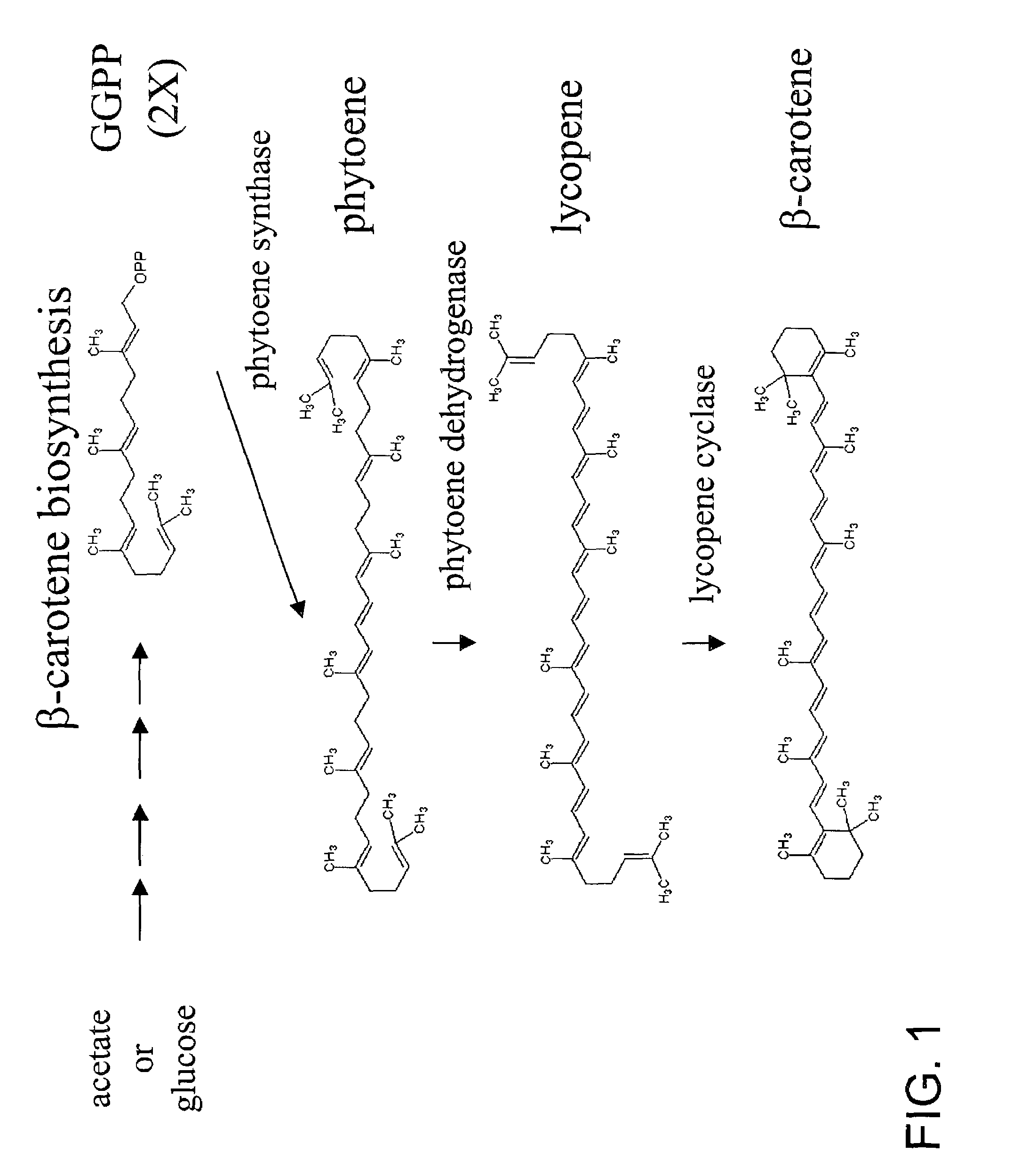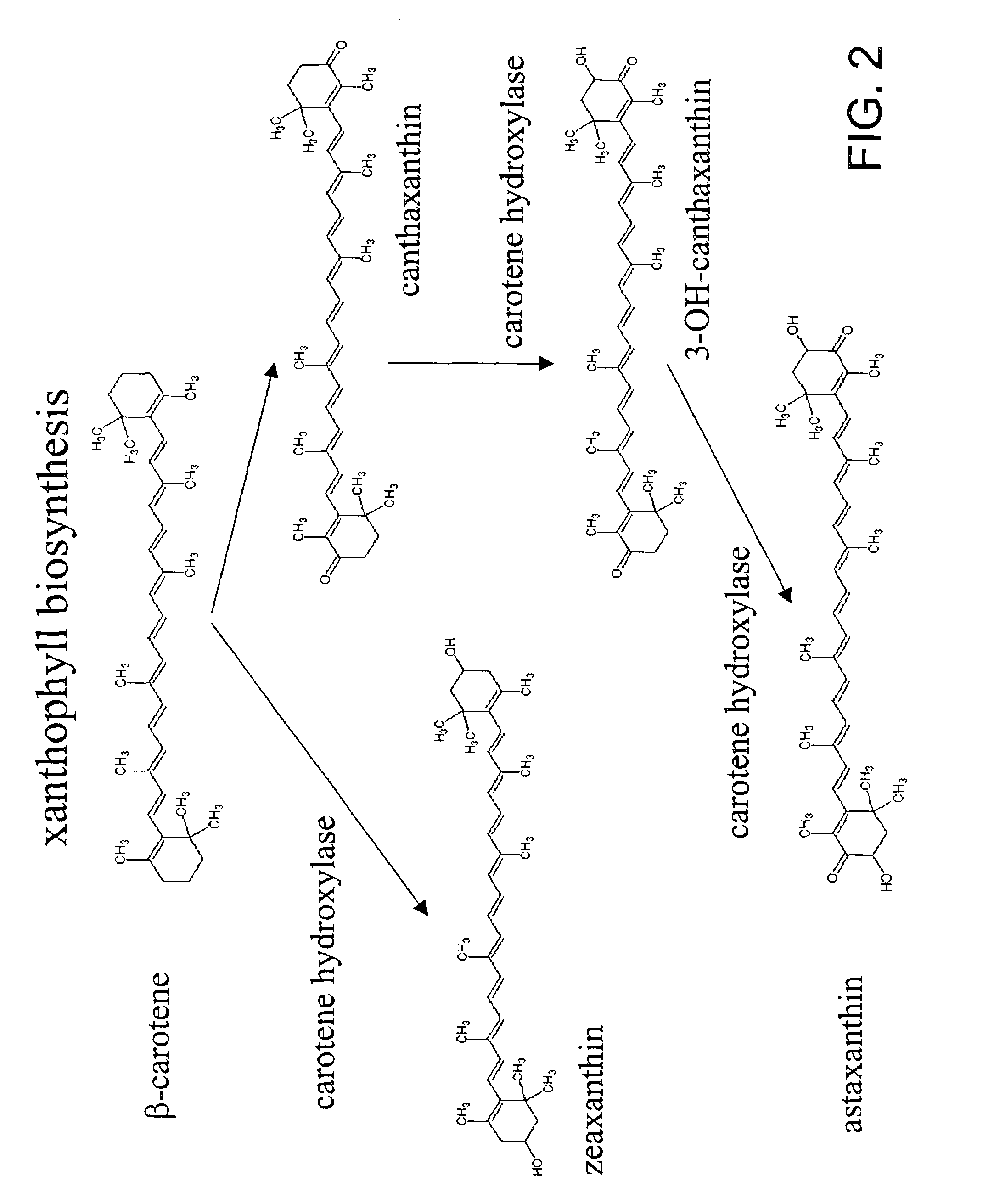Carotene synthase gene and uses therefor
- Summary
- Abstract
- Description
- Claims
- Application Information
AI Technical Summary
Benefits of technology
Problems solved by technology
Method used
Image
Examples
example 1
[0134]The following example describes the identification, cloning and sequencing of the carotene synthase gene of the present invention.
[0135]Using an internal source of 8500 clones which had been previously sequenced from a Schizochytrium cDNA library, but which were not publicly available, BLAST searches were performed with the clone sequences. The translated sequence of one of these cDNA clones, designated LIB3033-014-Q1-E1-C9, showed strong homology to known phytoene synthase (PS) genes.
[0136]Starting with this DNA sequence of approximately 400 base pairs, the present inventors undertook an effort to isolate the Schizochytrium gene having homology to known PS genes. A series of DNA primers were designed and used in “Genome Walker” PCR protocols with Schizochytrium chromosomal DNA as a template to sequentially identify adjacent DNA regions. The libraries were constructed using a commercial kit (Clonetech, Inc.; Palo Alto, Calif.) and Schizochytrium genomic DNA. Successful PCR pro...
example 2
[0152]The following example demonstrates the expression and function of the carotene synthase gene of the invention.
[0153]Subsequent efforts have centered on demonstrating function of the CS gene. Successful expression and function of the CS gene in homologous and heterologous hosts would be of great benefit for using the CS gene and its product in a variety of applications. Toward these ends, three parallel expression plasmid designs were prepared. Additionally, plasmids designed to “knock out” chromosomal CS gene expression either by single cross-over homologous recombination or double cross-over recombination have been constructed and tested by transformation (see Example 3). Details of plasmid construction are as follows.
pCSZEO1 and pCSZEO2: (for Expression of CS and LC-Defective CS from its Native Promoter)
[0154]The ca. 5.1 kb EcoRI fragment from pCX017 (containing the entire CS ORF (positions 1406–5212 of SEQ ID NO:1)), all of the upstream cloned DNA (positions 1–1405 of SEQ I...
example 3
[0174]This example describes the inactivation of a carotene synthase gene in Schizochytrium.
Plasmid Construction
pCSKO1 pCSKO2, and pCSKO3
[0175]An internal CS ORF fragment (KpnI to HindIII; 2689 bp) was cloned into the compatible site in the commercial vector pTrcHis2B to give plasmid pL35-4.
[0176]Plasmid pL35-4 was further amended to include the “TZS” cassette from pTUBZEO11-2 as an 1122 bp XbaI fragment by linearization of pL35-4 with XbaI, treatment with shrimp alkaline phosphatase, and ligation with the gel-purified 1122 bp XbaI fragment from pTUBZEO11-2. The resulting plasmid, pCSKO1, is designed to inactivate (“knock out”) the chromosomal CS gene by single cross-over homologous recombination following transformation into Schizochytrium with selection for Zeocin resistance.
[0177]For plasmids designed to knock out the CS gene by double cross-over homologous recombination, the entire CS gene (including all of the known up-steam region and about 270 bp of down stream region (to th...
PUM
| Property | Measurement | Unit |
|---|---|---|
| Fraction | aaaaa | aaaaa |
| Digital information | aaaaa | aaaaa |
| Digital information | aaaaa | aaaaa |
Abstract
Description
Claims
Application Information
 Login to View More
Login to View More - R&D
- Intellectual Property
- Life Sciences
- Materials
- Tech Scout
- Unparalleled Data Quality
- Higher Quality Content
- 60% Fewer Hallucinations
Browse by: Latest US Patents, China's latest patents, Technical Efficacy Thesaurus, Application Domain, Technology Topic, Popular Technical Reports.
© 2025 PatSnap. All rights reserved.Legal|Privacy policy|Modern Slavery Act Transparency Statement|Sitemap|About US| Contact US: help@patsnap.com



